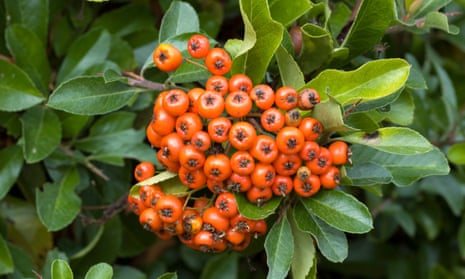Some plants divide opinion. Think of Beth Chatto rushing to the defence of Bergenia while reading Christopher Lloyd’s The Well-Tempered Garden, or try mentioning conifers to a group of gardeners and watch what happens.
Then there is the plant responsible for shattering my belief that year-round interest is a synonym for year-round mediocrity: Pyracantha.
Pyracantha (aka firethorn) is the ultimate multitasking plant; a workhorse shrub capable of stepping into the spotlight and shining, not once, but twice a year. Billows of frothy white flowers buzz with pollinators in early summer. Great pendulous bunches of red, orange or yellow berries attract birds in winter. As if this is not enough, glossy evergreen foliage gives colour and structure to the garden all year round while providing shelter for nesting and roosting.
Anything so hugely valuable to wildlife surely has to be embraced, although to embrace Pyracantha in the physical sense would be folly, as its common name, firethorn, suggests. However, those thorns do make an excellent security barrier, and they protect the wildlife sheltering within.
I view Pyracantha as the perfect garden guest. It behaves exactly as I wish because it is trainable. It does not mind being clipped so it makes a useful hedging plant, but when shaped into an espalier it is a stylish, eye-catching and structurally valuable addition to the garden. Not only that, it tolerates some shade and grows in most soils, including dry ones.
Training Pyracantha allows us to grow it in a relatively small space. There should be a framework of wire or trellis in place prior to planting. Having donned some protective gloves, plant Pyracantha about 50cm from the wall or fence and train it like an espalier apple until the framework has been filled. I prune espalier Pyracantha during the flowering season to ensure that I conserve as many future berries as possible.
So long as no birds are nesting in the plant, I cut back any unwanted side shoots to about three leaves above the flowers. If pruning later in the summer, I cut back to three leaves above the ripening berries. Extending the coverage of the plant is easy. Simply tie young, pliable growth to the wire or trellis, and let it get on with the business of filling the space.
Pyracantha is tough and capable of tolerating a range of inhospitable garden conditions. It is also relatively inexpensive to buy. Does cost, year-round interest, and ease of cultivation somehow cheapen a plant and make it less desirable? A cheap plant is perfectly capable of looking a million dollars when festooned in blossom or dripping in berries.
Pyracantha is a valuable plant for wildlife. Isn’t it about time we all valued it too?
- Sarah Shoesmith is a garden designer who gardens with wildlife in mind. She blogs about gardening and growing her own food at The Gardening Shoe.
